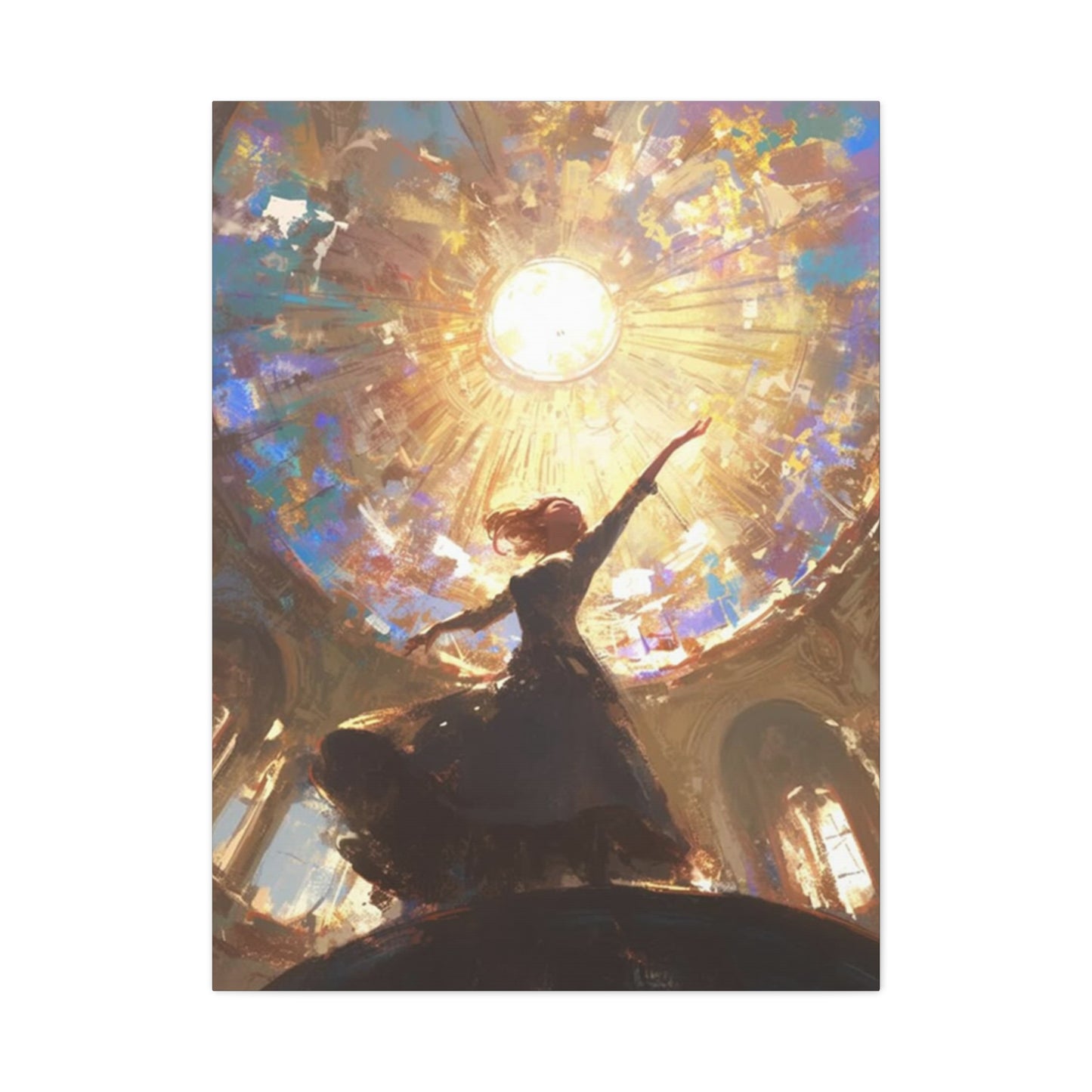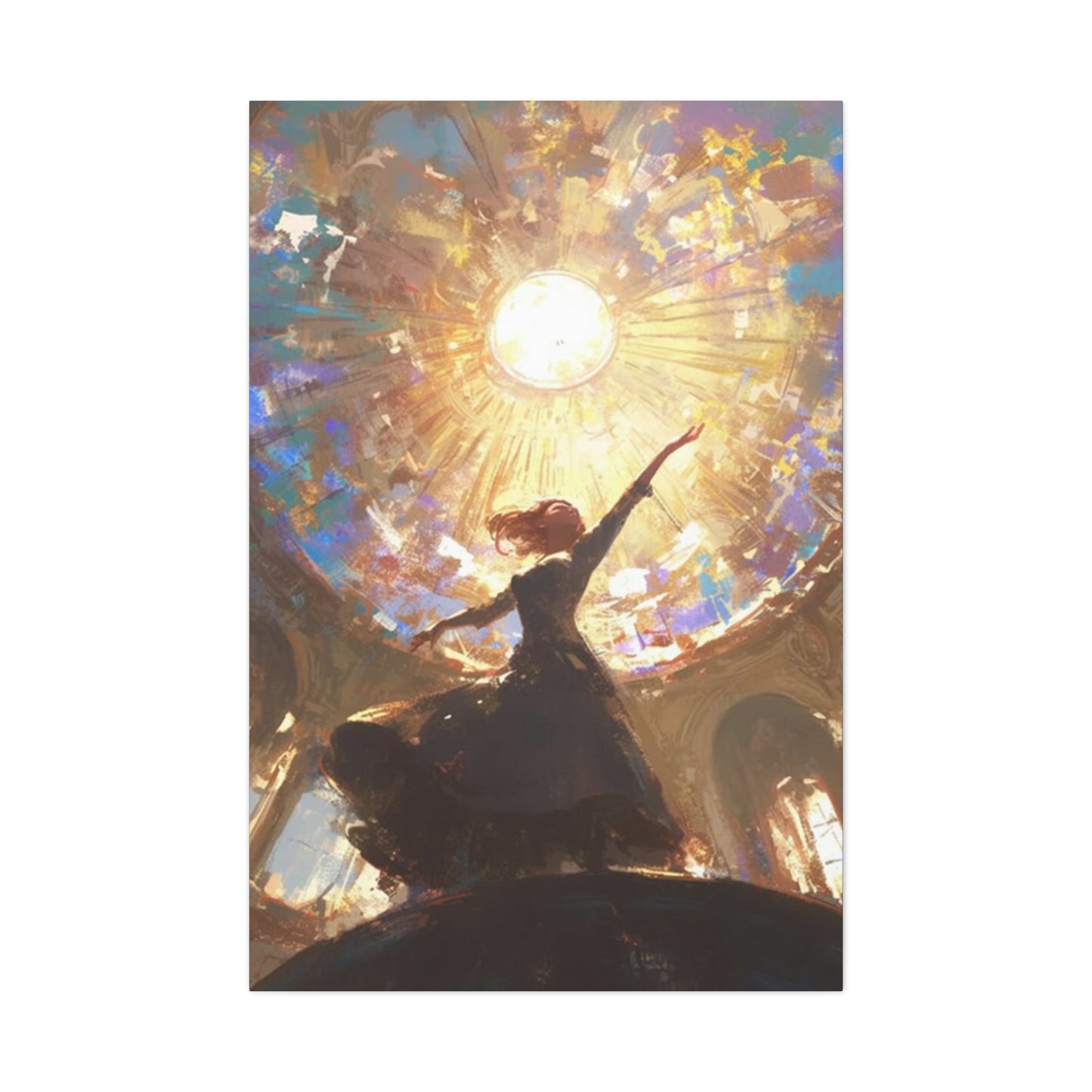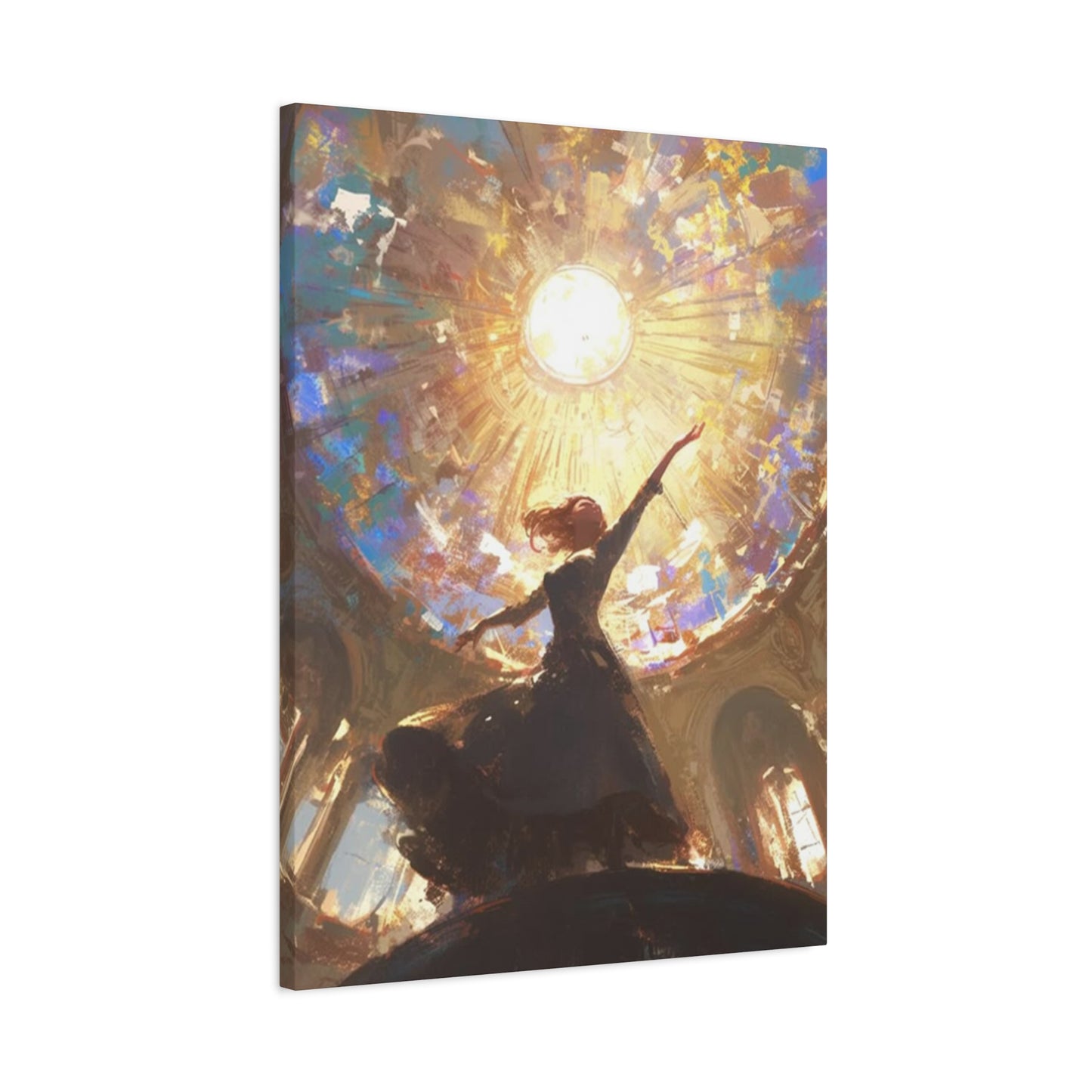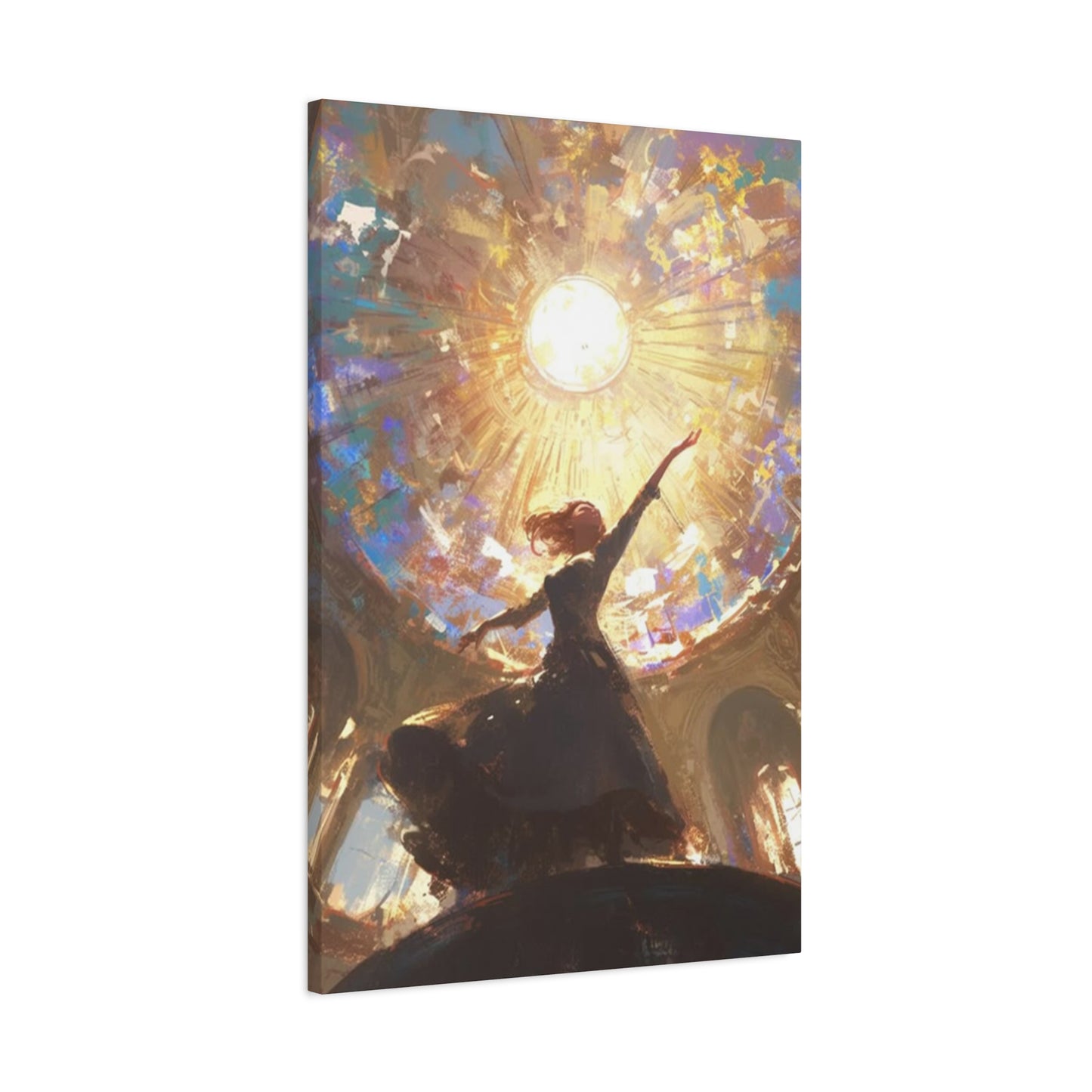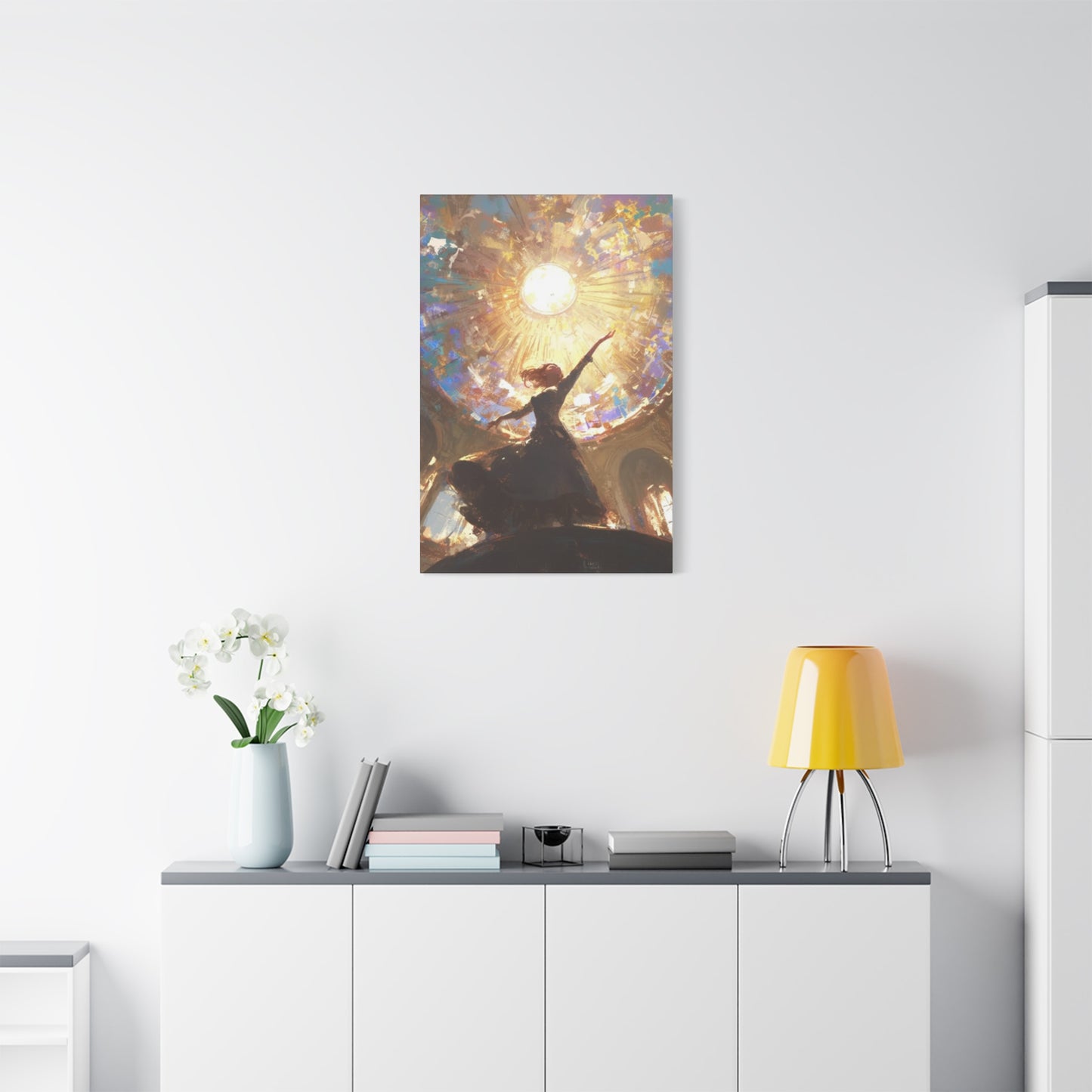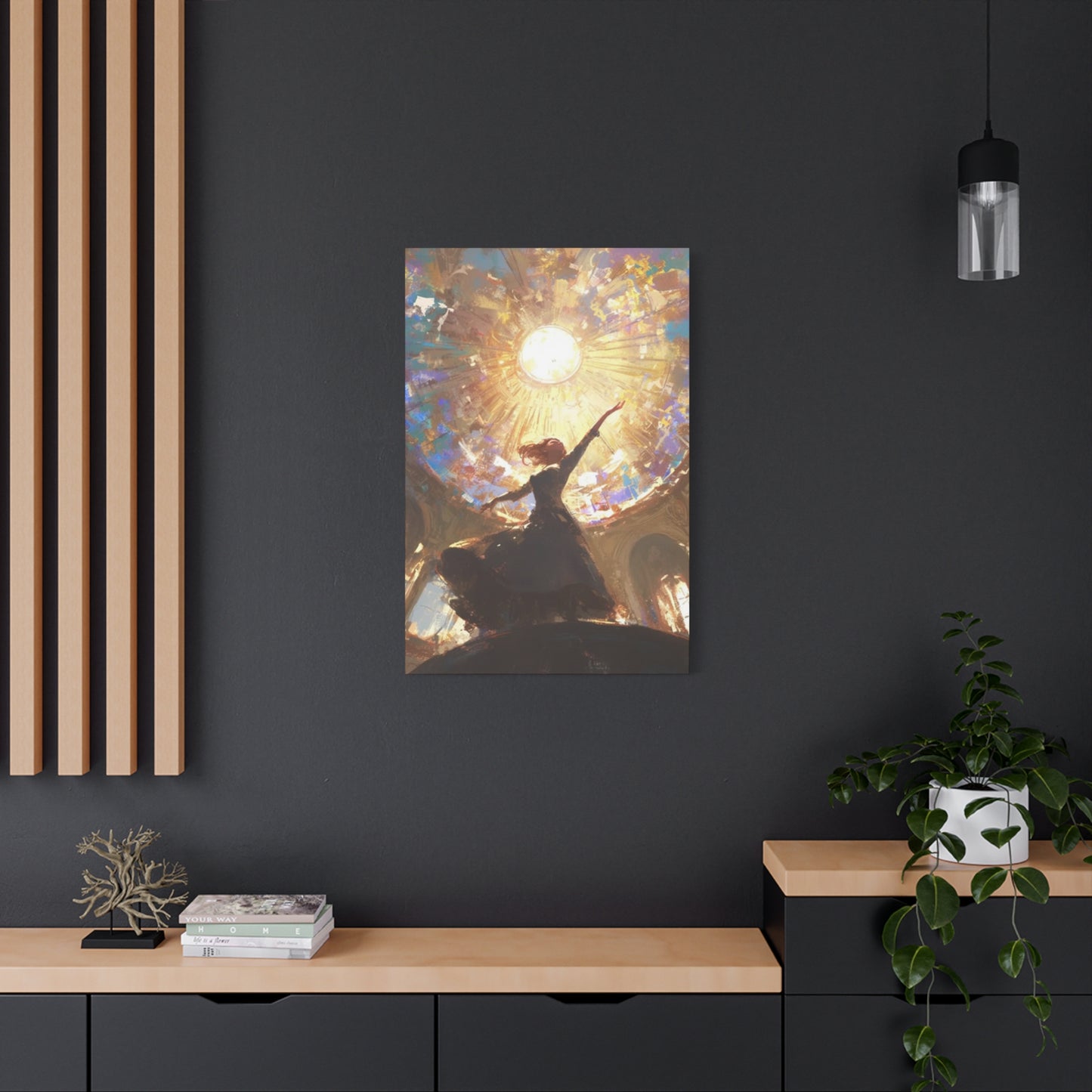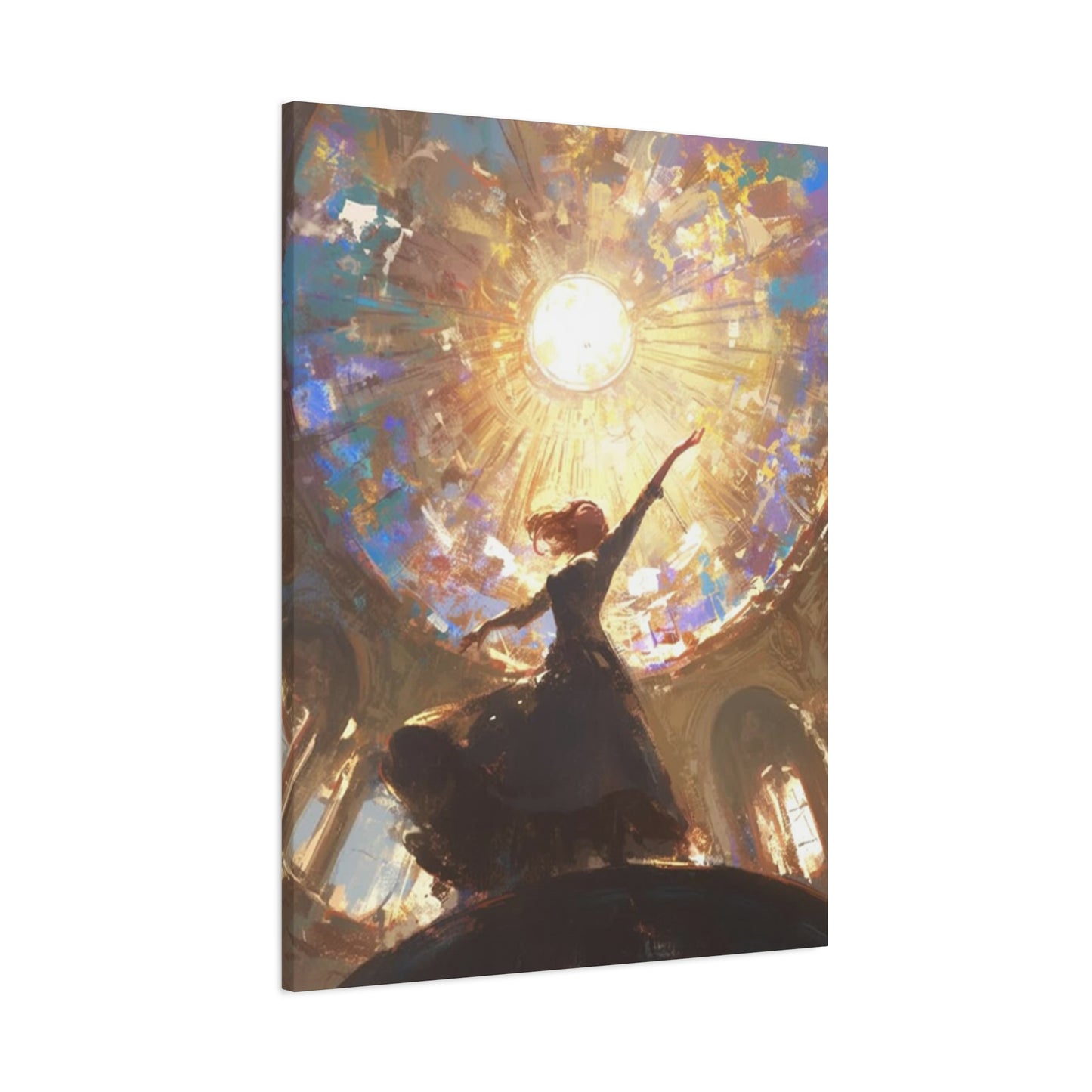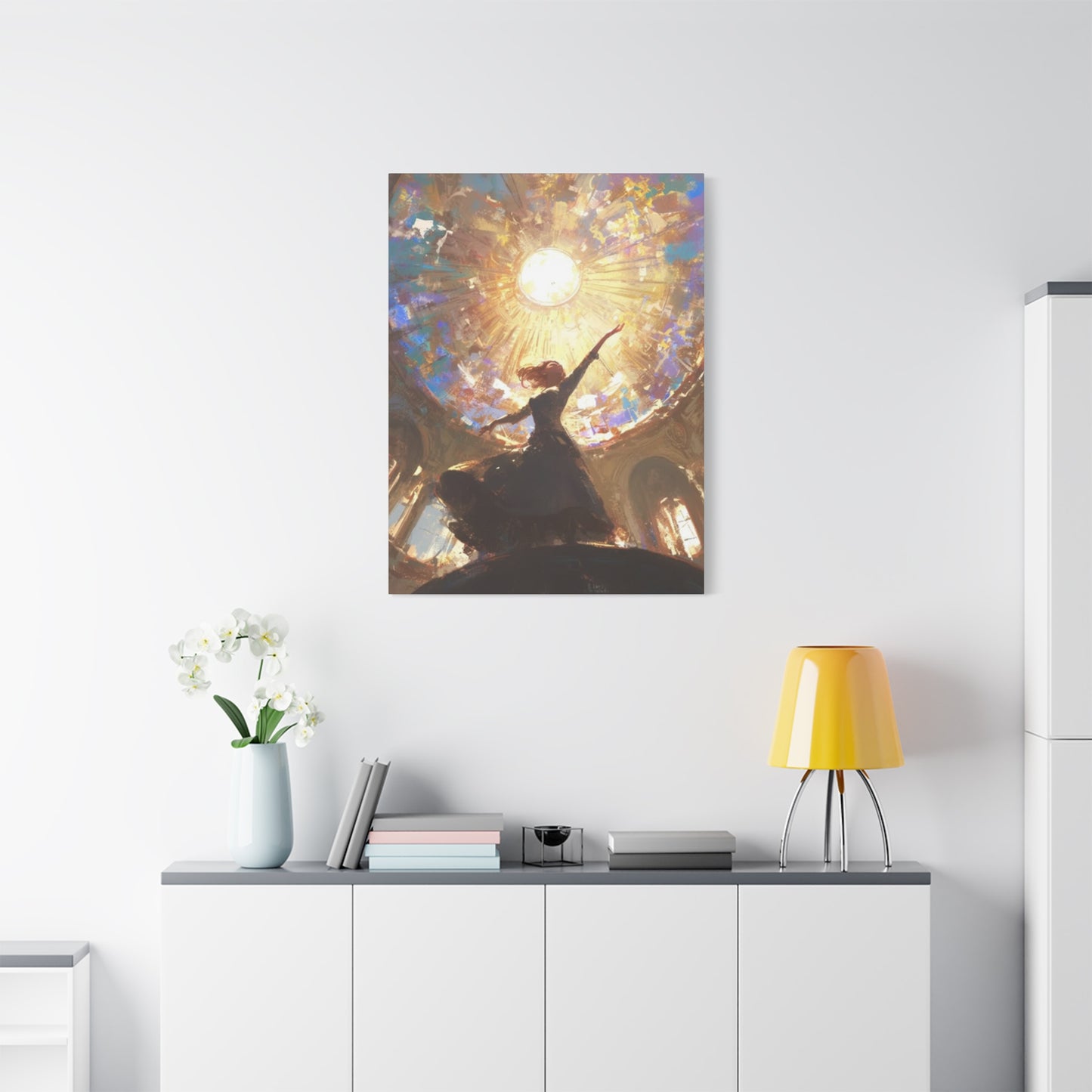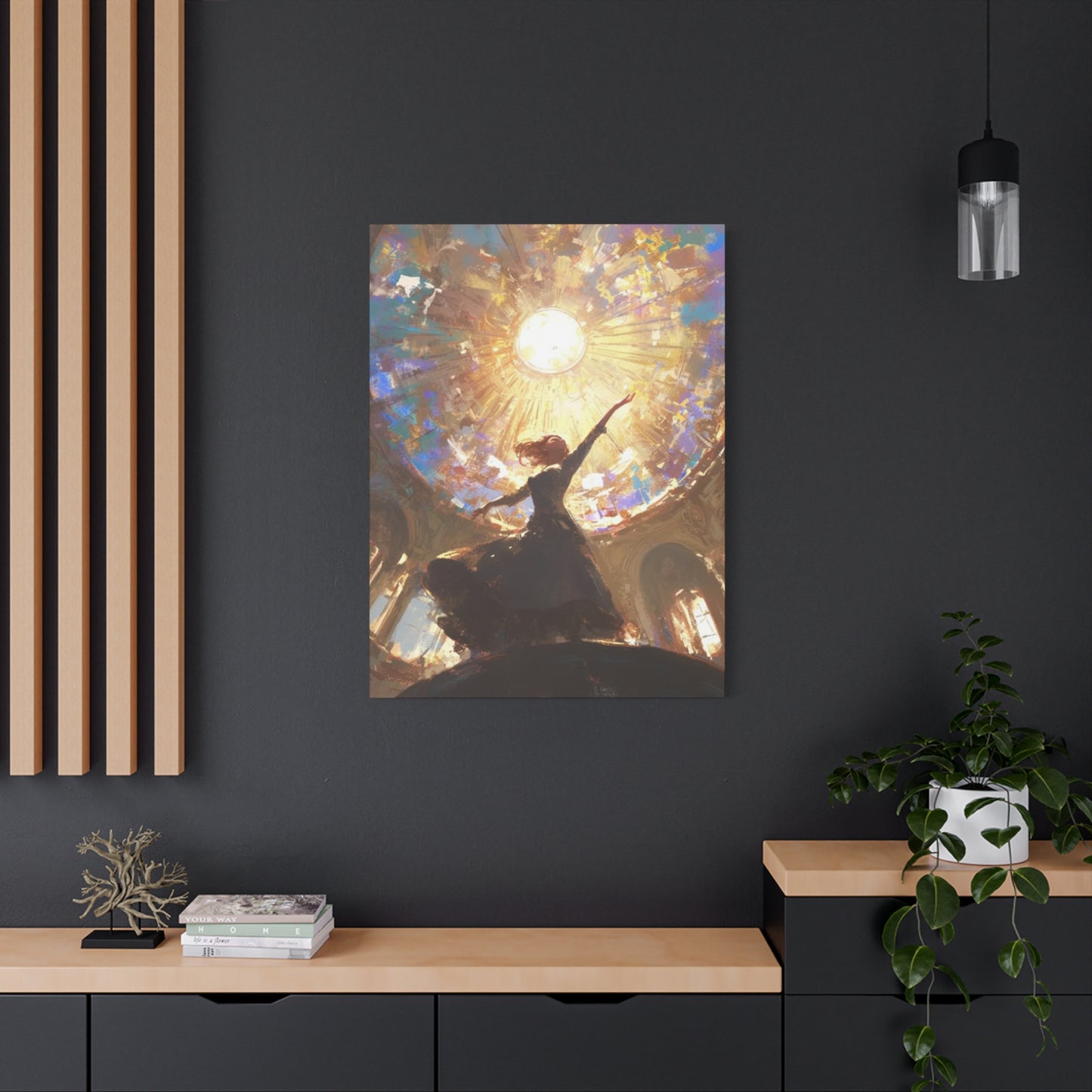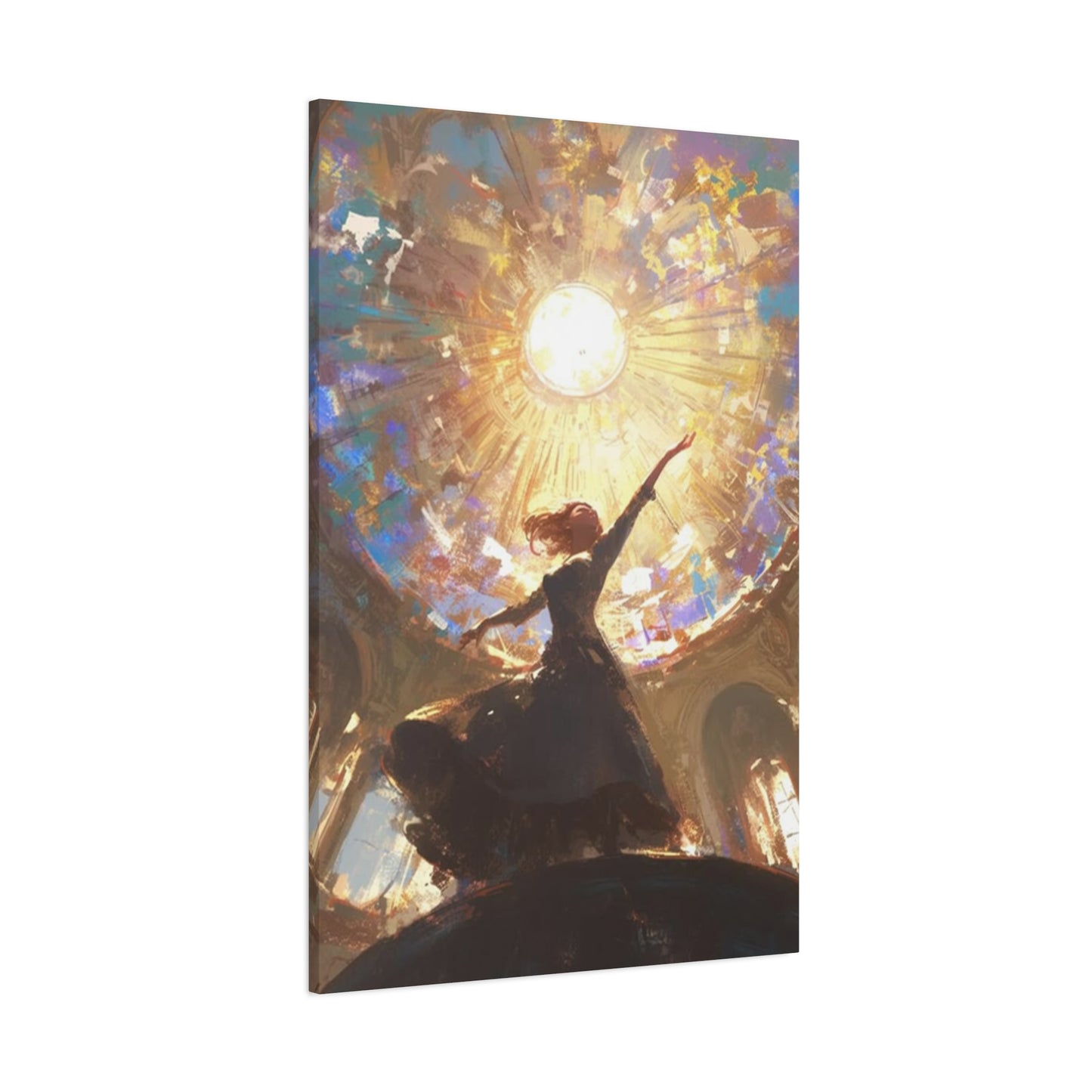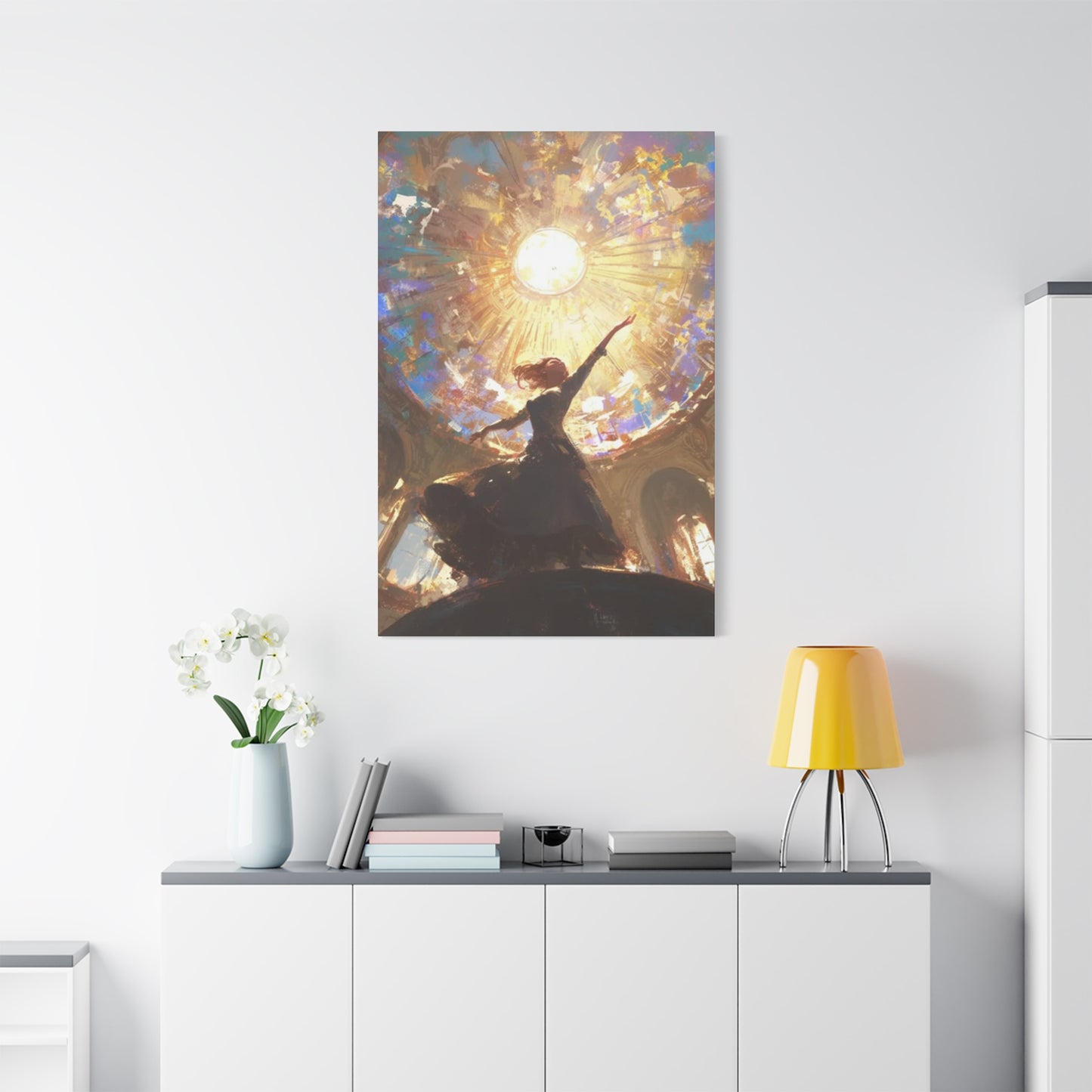The Dance of Divinity: Understanding the Spiritual Essence of Women in Light-Focused Wall Art
The intersection of spirituality and artistic expression has long captivated human imagination, and few subjects embody this convergence as powerfully as the depiction of female figures engaged in sacred movement. Throughout civilizations, the portrayal of women moving in spiritual contexts has served as a bridge between earthly existence and transcendent realms. This profound connection manifests in contemporary artwork that captures feminine energy through rhythmic motion, creating visual narratives that speak to the soul's deepest yearnings.
When examining these artistic representations, we discover layers of meaning that extend far beyond mere aesthetic appreciation. The female form in motion becomes a vessel for exploring humanity's relationship with the cosmos, the unseen forces that guide existence, and the universal language of physical expression that transcends cultural boundaries. Artists who focus on this theme understand that movement itself can be a form of prayer, a conversation with the infinite, and a celebration of life force energy that flows through all living beings.
The visual representation of women engaged in spiritual movement challenges viewers to reconsider their understanding of both femininity and divinity. These artworks invite contemplation on how physical expression can embody intangible spiritual concepts, how grace and power coexist in the female form, and how the act of moving through space can become a meditation on existence itself. The canvas becomes a stage where earthly and celestial realms merge, where the dancer serves as both participant and conduit for energies that exceed ordinary human experience.
Contemporary artists drawing from this tradition often incorporate luminous elements that suggest divine presence, creating compositions where radiance emanates from or surrounds the moving figures. This artistic choice reflects ancient beliefs about the relationship between illumination and spiritual awakening, between physical motion and the activation of consciousness. The resulting artworks function as visual poems that speak to the inherent sacredness of the female experience and the transformative power of embodied spiritual practice.
Radiance and Rhythm: Exploring Spiritual Luminosity in Female Movement
The concept of divine illumination has permeated religious and spiritual traditions across the globe, often manifesting as halos, aureoles, or radiant emanations surrounding holy figures. When this luminous quality intersects with depictions of women in motion, the resulting imagery carries profound symbolic weight. The interplay between brightness and movement suggests that spiritual awakening is not a static state but rather a dynamic process that unfolds through active engagement with the sacred.
Artists working in this genre frequently employ color palettes that evoke celestial phenomena, utilizing golds, whites, and ethereal blues that reference both heavenly realms and natural light sources. These chromatic choices work in concert with the portrayal of motion to create a sense of transcendence, as if the figures depicted exist simultaneously in physical reality and in elevated spiritual dimensions. The illumination serves multiple functions within these compositions: it draws the viewer's eye to focal points, creates depth and atmosphere, and symbolically represents the presence of higher consciousness or divine attention.
The technical execution of these luminous elements requires considerable skill, as artists must balance realism with mystical suggestion. Some creators achieve this through traditional techniques like chiaroscuro, using stark contrasts between brightness and shadow to sculpt form and create drama. Others employ more contemporary approaches, layering translucent colors or incorporating reflective materials that literally catch and redirect ambient light. Regardless of methodology, the goal remains constant: to visually communicate the ineffable experience of spiritual elevation through physical expression.
Beyond technical considerations, the symbolic implications of radiance in these artworks connect to universal human experiences. Light has long represented knowledge, purity, divine favor, and spiritual enlightenment across cultures. When this symbolism combines with the depiction of female figures in sacred movement, it suggests that women's spiritual practices and physical expressions are worthy of reverence, that the feminine path to transcendence holds equal validity with masculine approaches, and that the female body in motion can serve as a temple for divine presence.
Symbolic Language: Decoding Sacred Imagery in Female Movement Art
Every element within artworks depicting women in spiritual motion carries potential symbolic significance, creating a rich visual vocabulary that rewards careful observation. The positioning of limbs, the direction of gaze, the relationship between figures and their environment—all contribute to the narrative these pieces communicate. Understanding this symbolic language enhances appreciation for both the artist's intentions and the deeper meanings embedded within the composition.
Hand gestures, known as mudras in various spiritual traditions, often feature prominently in these artworks. Each finger position can convey specific meanings: hands raised skyward might indicate supplication or receiving blessings, while hands pressed together at the heart center suggest meditation or gratitude. Arms extended outward can symbolize offering or embrace, while circular movements might reference the cyclical nature of existence. Artists familiar with these traditional gesture languages incorporate them deliberately, adding layers of meaning that resonate with viewers who recognize these symbols.
The positioning of the female figures within the compositional space also carries significance. Figures ascending or reaching upward generally suggest aspiration toward higher consciousness or divine connection. Those grounded firmly, with feet planted or knees bent, might represent the importance of earthly connection even while pursuing spiritual elevation. Spiral movements often reference sacred geometry, the unfurling of consciousness, or the kundalini energy believed to rise through the body during spiritual awakening. The direction of movement—clockwise or counterclockwise—can even hold symbolic meaning in certain traditions.
Surrounding elements within these compositions function as supporting characters in the visual narrative. Flowing fabrics might represent the veil between physical and spiritual realms, or the fluidity of consciousness itself. Architectural elements like columns or arches can frame the central figures, creating sacred spaces within the artwork. Natural elements such as water, fire, earth, or air frequently appear as symbolic representatives of elemental forces or stages of spiritual transformation. Even the choice of whether to include or exclude these contextual elements makes a statement about the relationship between the sacred feminine and the broader cosmos.
Divine Embodiment: The Female Form as Spiritual Canvas
The representation of the female body in spiritual contexts has evolved considerably throughout art history, reflecting changing cultural attitudes toward women, spirituality, and the intersection of physicality with the sacred. Contemporary artists working in this space often navigate complex terrain, seeking to honor the female form while avoiding objectification, celebrating physical beauty while emphasizing spiritual depth, and acknowledging historical traditions while offering fresh perspectives.
Within these artworks, the female body becomes more than anatomical reality; it transforms into a symbolic landscape where spiritual truths are written in curves, angles, and the spaces between. The spine might represent the axis mundi, the central pole connecting heaven and earth. The heart center becomes the seat of compassion and divine love. The pelvis, traditionally associated with creative and life-giving power, symbolizes connection to generative forces that extend beyond physical reproduction to include artistic, intellectual, and spiritual creation.
Artists approaching this subject with sensitivity recognize that the female form carries cultural baggage and historical associations that must be acknowledged and sometimes subverted. Throughout Western art history, the nude female figure has frequently served male gaze and fantasy rather than expressing authentic female experience or spiritual power. Contemporary creators working in this genre often make deliberate choices to reclaim the female body as a site of agency, wisdom, and spiritual authority rather than passive objectification.
The depiction of movement adds another dimension to these representations, as bodies in motion reveal different aspects than static poses. The extension of a leg, the arch of a back, the sweep of an arm through space—these movements demonstrate strength, flexibility, control, and abandon simultaneously. They show the female form as capable, powerful, and graceful, challenging reductive stereotypes while celebrating the genuine beauty of bodies moving with intention and skill. The physicality of these depictions grounds the spiritual themes in embodied reality, suggesting that transcendence need not require rejection of the physical realm.
Luminous Elegance: The Interplay of Brightness and Fluid Motion
The technical challenge of depicting both brightness and movement within a single composition requires artists to master multiple skills simultaneously. Motion implies time, a fourth dimension that static visual art must suggest through compositional techniques. Illumination involves understanding how light behaves, reflects, absorbs, and transforms as it interacts with various surfaces. Combining these elements demands both technical proficiency and artistic vision.
Artists employ various strategies to convey movement in two-dimensional media. Blurred edges or multiple limb positions can suggest the trajectory of motion. Flowing hair and fabric create directional lines that guide the viewer's eye and reinforce the sense of dynamic action. The positioning of figures within the frame—off-center, diagonal, or appearing to move beyond the boundaries—contributes to kinetic energy. Some contemporary creators even incorporate mixed media elements like actual fabric or three-dimensional components that physically extend from the canvas, literalizing the concept of movement breaking free from flat constraints.
The representation of illumination presents its own technical demands. Traditional approaches rely on careful observation of how brightness affects color, value, and edge quality. Areas touched by direct illumination become lighter and often more saturated, while shadows introduce cooler tones and softer transitions. Reflected brightness bounces between surfaces, creating subtle color shifts and preventing shadows from becoming flat or dead. Contemporary artists sometimes supplement traditional painting techniques with innovative materials: phosphorescent pigments that literally glow, metallic foils that catch and reflect ambient light, or translucent layers that create depth and luminosity.
When motion and radiance combine, the resulting visual effect can approach the mystical. Brightness seems to trail behind moving forms or emanate from them, creating aureoles of energy that suggest more than physical presence. The illumination itself appears to participate in the movement, swirling, pulsing, or flowing in sympathy with the dancing figures. This synthesis communicates the core concept underlying much spiritual art: that physical action and divine presence are not separate phenomena but rather different aspects of unified existence.
Contemporary Expressions: Modern Interpretations of Ancient Themes
Today's artists working with themes of sacred feminine movement draw from rich historical traditions while bringing contemporary sensibilities to their creations. This balance between honoring the past and speaking to present-day audiences requires both knowledge and innovation. The resulting artworks function as bridges across time, connecting ancient wisdom with modern understanding, traditional symbolism with current visual languages.
Many contemporary creators consciously reference specific historical periods or cultural traditions in their work. Some draw inspiration from Indian classical practices where the female form performs mudras and poses loaded with spiritual significance. Others look to mystical Middle Eastern traditions or the ecstatic practices of various religious orders. African spiritual traditions, with their emphasis on rhythm and community celebration, provide another rich source of imagery and symbolism. By incorporating these diverse influences, modern artists create work that acknowledges the global nature of sacred feminine expression while avoiding cultural appropriation through respectful study and attribution.
The materials and techniques available to contemporary artists have expanded dramatically beyond those accessible to historical creators. Digital tools allow for experimentation with color, composition, and effect that would be impractical or impossible with traditional media alone. Some artists create hybrid works that begin with conventional painting or drawing but are then scanned, manipulated digitally, and output through specialized printing processes. Others work entirely in digital realms, using sophisticated software to build images layer by layer, incorporating photographic elements, hand-drawn components, and computer-generated effects into cohesive wholes.
Despite these technological advances, many artists deliberately choose traditional materials and techniques, valuing the physical connection between creator and creation that comes from directly applying paint to canvas or carving into wood or stone. These artists often speak of their creative process in spiritual terms, describing the act of making art as itself a form of meditation or prayer. The choice of traditional methods becomes a statement about values: about the importance of hand skill, the wisdom embedded in time-tested techniques, and the energetic difference between digitally generated images and those created through direct physical engagement.
Sacred Femininity: Movement as Spiritual Language
The concept that physical movement can function as spiritual practice appears across human cultures throughout history. From Sufi whirling to ecstatic Jewish traditions, from Native American ceremonial practices to Christian liturgical processions, movement has served as a pathway to altered consciousness, divine communion, and religious expression. The specific association of feminine energy with sacred expression through motion carries particular significance, often connecting to concepts of creation, intuition, receptivity, and cyclical transformation.
In many spiritual frameworks, feminine energy is understood not simply as the quality possessed by female-bodied individuals but as a universal principle that exists in all people and throughout nature. This energy is often characterized as receptive rather than projective, intuitive rather than intellectual, flowing rather than rigid, and connected to natural cycles and rhythms. When artists depict women engaged in sacred movement, they tap into these archetypal associations, creating images that resonate at deep, often subconscious levels with viewers regardless of their gender identity.
The movements themselves often mirror patterns found in nature: spirals echo the unfurling of ferns or the structure of galaxies, wavelike motions reference the rhythms of ocean tides or breathing, circular paths invoke the cycling of seasons or phases of the moon. By connecting human physical expression with natural phenomena, these artworks suggest that the sacred feminine is not separate from nature but rather intimately woven into its fabric. The dancing woman becomes a microcosm reflecting macrocosmic forces, a small embodiment of vast universal patterns.
Contemporary discussions of gender and identity add new dimensions to interpretation of these artworks. As understanding of gender as a spectrum rather than binary grows, the concept of sacred feminine energy becomes more inclusive, available to anyone regardless of their physical form or gender identity. Artists working with these themes increasingly create images that transcend biological essentialism, depicting spiritual movement as accessible to all who approach it with sincerity and openness. This evolution allows the tradition to remain vital and relevant while honoring its historical roots.
Female Vision: Sacred Expression Through Female Artists' Eyes
While men have created much of the historical artistic canon depicting women in religious or spiritual contexts, contemporary female artists bring unique perspectives to these subjects. Creating from lived experience rather than external observation, these artists often infuse their work with insights about feminine spirituality that differ markedly from male-generated interpretations. Their artworks frequently challenge historical patterns of objectification, offering instead depictions rooted in authentic female experience and spiritual practice.
Female creators working in this space often emphasize aspects of experience that male artists historically overlooked or minimized. The physical sensations of movement—the feeling of muscles engaging, the awareness of breath, the relationship between body and gravity—appear with greater specificity and nuance. The emotional and psychological dimensions of spiritual practice receive more attention, acknowledging that transcendence involves not just physical technique but also mental and emotional states. The vulnerability inherent in spiritual seeking, often hidden or minimized in traditionally masculine approaches to religion, finds frank acknowledgment in many women's artistic explorations.
These artists also tend to create work that celebrates diverse body types, ages, and appearances, countering narrow historical beauty standards that dominated Western art for centuries. The dancing figures in their artworks might be older women, bodies marked by childbearing or age, or forms that deviate from classical proportions. This inclusive approach communicates that spiritual expression through movement is not the exclusive province of young, conventionally beautiful bodies but is available to all women regardless of their physical characteristics.
The relationship between female artists and female subjects in spiritual art also allows for exploration of themes that might feel exploitative coming from male creators. Vulnerability, sensuality, emotional intensity, and the intersection of physical and spiritual pleasure can be depicted with authenticity and nuance when created by women exploring their own experiences. The resulting artworks often carry an intimacy and honesty that invites viewers into genuine contemplation rather than voyeuristic observation.
Celestial Choreography: Patterns of Sacred Movement in Visual Art
The specific movements depicted in artworks of women engaged in spiritual expression often follow patterns with deep historical and symbolic significance. These choreographies are not arbitrary but rather draw from codified systems of meaning that have developed over centuries across various cultures. Understanding these movement patterns enhances appreciation for the intentionality behind artistic choices and the layers of meaning embedded in seemingly simple gestures.
Circular movements appear frequently in these depictions, referencing the cyclical nature of existence, the eternal return, the wheel of dharma, or the mandala structure found in many spiritual traditions. The dancing figure might be shown tracing circles with her body, spinning on a central axis, or incorporating spiral patterns that simultaneously reference circles while also suggesting ascension or descent. These circular motions connect to feminine associations with lunar cycles, seasonal transitions, and the rhythms of birth, death, and renewal.
Reaching or ascending movements communicate aspiration toward divine connection, the desire to transcend earthly limitations, or the experience of spiritual elevation. Arms extended upward, bodies appearing to levitate or float, positions balanced on tiptoes—these elements create a sense of defying gravity, of existing temporarily between earth and sky. Such movements might reference ladder symbolism, the concept of Jacob's ladder or spiritual hierarchies in which consciousness ascends through progressive levels of refinement and illumination.
Grounded movements emphasize connection to earth, to physical reality, to the body as temple and source of wisdom. Deep knee bends, flat-footed stances, and positions that spread weight broadly across the ground communicate stability, rootedness, and the importance of earthly existence even in spiritual practice. These grounded movements often balance ascending gestures within the same composition, suggesting the integration of transcendent aspirations with embodied presence.
Radiant Presence: Creating Atmosphere Through Luminous Effects
The atmosphere created within artworks depicting women in sacred movement owes much to the handling of luminous elements. These effects do more than illuminate the scene; they create mood, suggest transcendent presence, direct viewer attention, and transform realistic depictions into visionary experiences. The mastery of these atmospheric effects separates merely competent work from truly affecting artistic achievements.
Some artists create distinct light sources within their compositions—a sun, moon, candles, or ambiguous celestial bodies that cast illumination across the scene. This approach grounds the radiance in recognizable reality while allowing for poetic interpretation. The source might be impossibly bright, casting light that seems more intense than natural phenomena could produce, suggesting divine or supernatural origins. Alternatively, multiple light sources might appear, creating complex patterns of illumination and shadow that fragment the space into a mosaic of brightness and darkness.
Other creators take more abstract approaches, depicting illumination that has no identifiable source but seems to emanate from the figures themselves or from the environment generally. This sourceless brightness communicates immanent divinity—the concept that the sacred exists within all things rather than originating from an external deity. When the dancing woman glows from within, the artwork suggests that spiritual practice awakens latent divinity already present in the practitioner rather than drawing down external blessing.
The quality of brightness also varies significantly between artworks. Some depict soft, diffused radiance that gently illuminates without harsh contrasts, creating peaceful, meditative atmospheres. Others employ stark, dramatic contrasts between intense brightness and deep shadow, producing more theatrical, emotionally charged effects. The color temperature of illumination—warm golden tones versus cool silvery lights—contributes to the emotional tenor of the piece. Warm illumination tends to feel comforting, nurturing, and life-affirming, while cooler tones can suggest mystery, transcendence, or intellectual rather than emotional spirituality.
Spiritual Expression: Movement as Prayer and Meditation
The understanding of physical movement as a form of prayer or meditation appears across spiritual traditions worldwide. This concept recognizes that consciousness and embodiment are inseparable, that the state of the body influences the state of the mind and spirit, and that intentional physical practices can induce altered states of awareness that facilitate spiritual experience. Artworks depicting women in sacred movement often aim to capture these moments of consciousness transformation.
In many contemplative traditions, repetitive physical movements serve as a focus for meditation, occupying the conscious mind sufficiently to allow deeper awareness to emerge. The rhythm of steps, the pattern of breathing, the sensation of muscles engaging and releasing—these become objects of meditation comparable to mantras or visualization practices. Artists attempting to capture this meditative quality often emphasize rhythmic patterns in their compositions, using repeated elements or flowing lines that mirror the repetitive nature of the movements themselves.
The relationship between breath and movement carries particular significance in many spiritual practices. Breath represents the bridge between conscious control and automatic functioning, between body and spirit, between self and environment. When artistic depictions successfully convey the breath quality of sacred movement—suggesting the inhalation that initiates an arm's rise or the exhalation that accompanies a deep bend—they tap into visceral responses in viewers who unconsciously synchronize their own breathing with the implied rhythm.
The psychological and emotional states associated with spiritual movement also become subjects for artistic exploration. The faces of depicted figures might show serene concentration, ecstatic joy, intense focus, or the peaceful absence of thought associated with deep meditation. Some artists choose to obscure or minimize facial features, suggesting that individual personality dissolves during spiritual practice, subsumed into larger universal consciousness. Others emphasize expressive faces, validating the full range of human emotion as legitimate components of spiritual experience.
Modern Spirituality: Contemporary Approaches to Sacred Art
Contemporary spiritual seekers often synthesize elements from multiple traditions, creating personalized practices that honor diverse sources while remaining authentic to individual experience. This eclectic approach finds visual expression in artworks that blend imagery from different cultural contexts, combine ancient symbolism with modern aesthetic sensibilities, and speak to spirituality as a universal human impulse rather than the exclusive property of any single religion or tradition.
Modern spiritual art often strips away the specific iconography that would identify a practice as belonging to a particular religious tradition, instead focusing on universal themes and imagery. The dancing woman might not clearly represent a Hindu devadasi, a Sufi dervish, a Christian mystic, or a practitioner of any other specific tradition. This deliberate ambiguity allows viewers from diverse backgrounds to find personal meaning in the work, seeing their own spiritual experiences reflected regardless of their particular practice or belief system.
The aesthetics of contemporary spiritual art also tend toward accessibility rather than the formal qualities that characterized much historical religious art. While Byzantine icons followed rigid compositional rules and Renaissance religious art emphasized technical perfection, much modern spiritual art embraces spontaneity, emotional expression, and aesthetic approaches that prioritize feeling over formal perfection. This shift reflects broader cultural changes in how spirituality is conceptualized—less as adherence to external authority and more as authentic personal experience.
Technology's role in both creating and disseminating spiritual art represents another significant contemporary development. Digital tools allow artists to experiment and iterate rapidly, trying multiple color schemes, compositions, or effects before committing to a final version. The internet enables spiritual art to reach global audiences instantly, building communities of creators and viewers who might never meet physically but who share interests and values. Social media platforms become virtual galleries where spiritual art circulates, accumulating responses and interpretations that add layers of meaning beyond the artist's original intentions.
Inspirational Impact: How Sacred Movement Art Affects Viewers
The power of visual art to move viewers emotionally, inspire contemplation, and even catalyze personal transformation has long been recognized. Artworks depicting women in sacred movement carry particular potential for impact, combining aesthetic beauty with spiritual themes in ways that bypass intellectual analysis and speak directly to deeper levels of consciousness. Understanding how these artworks affect viewers illuminates their value beyond mere decoration.
Many viewers report that images of women engaged in spiritual movement inspire their own practice, serving as visual reminders of commitments to meditation, yoga, or other contemplative disciplines. These artworks function as sacred objects in secular contexts, bringing spiritual intentionality into everyday environments. The presence of such imagery in living spaces, workplaces, or studios creates atmosphere conducive to reflection and mindfulness, subtly influencing inhabitants' psychological states and behavioral choices.
The aesthetic pleasure derived from these artworks—their beauty, skillful execution, and harmonious composition—produces positive emotional states that viewers often describe in spiritual terms. Feelings of peace, upliftment, inspiration, or connection emerge from prolonged viewing, suggesting that the artwork serves as more than passive decoration but rather as an active participant in the viewer's emotional and spiritual life. This transformative capacity allies visual art with music, poetry, and other artistic forms long recognized for their ability to alter consciousness and facilitate spiritual experience.
For some viewers, particularly women or those who identify with feminine energy, these artworks provide rare representation of female spiritual authority and power. Historical religious art has overwhelmingly depicted male religious figures, prophets, saints, and deities. Images centering female spiritual experience validate women's religious agency and authority, countering centuries of marginalization. This representational impact should not be underestimated; seeing oneself reflected in spiritual imagery affirms that one's spiritual experiences are valid and valuable.
Spiritual Atmosphere: Creating Sacred Space Through Visual Art
The concept of sacred space—environments specifically designated for spiritual practice or experience—exists across cultures and throughout history. While temples, churches, mosques, and shrines represent physically constructed sacred spaces, visual art can also create sacred atmosphere within otherwise ordinary environments. Artworks depicting women in spiritual movement carry particular potency in this regard, transforming secular spaces into areas conducive to contemplation and spiritual awareness.
The presence of spiritual imagery functions as a kind of blessing or consecration of space, indicating that the environment is set apart for purposes beyond mundane daily activities. Even in homes or offices where formal religious practice does not occur, such artwork signals that spiritual values are honored and that space exists for reflection amid the demands of contemporary life. This designation need not be obvious or heavy-handed; subtle incorporation of spiritual imagery can create atmosphere without imposing any particular belief system or practice on others who share the space.
The specific qualities of artwork depicting sacred feminine movement contribute to particular atmospheric effects. The sense of motion creates energetic dynamism, preventing the space from feeling static or stagnant. The presence of light and luminous effects brightens the environment literally while also suggesting metaphorical illumination and awakening. The feminine energy emphasizes receptivity, intuition, and emotional awareness, balancing more masculine environmental qualities like angular architecture or technology-dominated spaces.
Interior design professionals increasingly recognize the psychological impact of visual elements within environments, understanding that artwork affects mood, productivity, creativity, and wellbeing. Spiritual themes add dimensions to these practical considerations, suggesting that environments can nourish not just physical comfort or aesthetic pleasure but also deeper aspects of human experience. The conscious curation of spiritual artwork becomes a form of environmental design that acknowledges humans as spiritual beings requiring nourishment on multiple levels.
Feminine Energy: Universal Principles in Visual Form
Spiritual and philosophical traditions worldwide recognize complementary energies or principles often characterized as masculine and feminine, yang and yin, solar and lunar, active and receptive. While these qualities may be personified through gendered figures, they represent universal forces present in all people and throughout nature. Artworks depicting women in sacred movement often explore these feminine principles, making abstract concepts tangible through visual metaphor.
Receptivity, frequently associated with feminine energy, should not be confused with passivity. Rather, it describes the capacity to receive inspiration, guidance, or blessing from sources beyond the individual ego. The open palm, the upturned face, the body positioned to receive rather than to project—these gestures communicate spiritual receptivity. Artworks emphasizing these qualities suggest that spiritual growth requires the ability to listen deeply, to surrender control, and to trust in guidance that may not emerge from rational thought processes.
Fluidity represents another quality associated with feminine energy. Unlike rigid structures or linear progressions, fluid motion adapts to circumstances, flows around obstacles, and follows the path of least resistance. Water symbolism frequently appears in spiritual art emphasizing feminine principles, as water embodies these qualities perfectly. The dancing female figure might be depicted with flowing movements that mirror water's behavior, suggesting that spiritual practice involves flexibility, adaptability, and the willingness to change form while maintaining essential nature.
The cyclical nature of feminine energy connects to biological realities like menstrual cycles while also representing broader patterns of birth, growth, death, and renewal. Artworks might incorporate spiral motions, circular compositions, or imagery suggesting seasonal transitions to emphasize these cyclical qualities. This perspective contrasts with linear models of spiritual progress that imagine advancement as a straight path toward a distant goal, instead proposing that spiritual growth follows patterns of spiral return, revisiting themes at deeper levels of understanding.
Spiritual Awakening: Movement as Catalyst for Transformation
The concept of spiritual awakening—a fundamental shift in consciousness that transforms one's understanding of self, reality, and existence—appears across spiritual traditions with remarkable consistency. While the triggering events or practices vary, many traditions recognize physical practices as valid pathways to these consciousness shifts. Artworks depicting women in transformative movement often aim to capture moments of awakening or to serve as catalysts inspiring viewers toward their own spiritual transformation.
The visual representation of awakening presents significant challenges, as the experience is primarily internal and subjective. Artists employ various strategies to suggest this invisible transformation. Dramatic lighting effects—figures emerging from darkness into brilliance, multiple light sources converging, or radiance emanating from the body—metaphorically represent the illumination of consciousness. Changes in the depicted figure's substance or solidity, with parts of the body becoming translucent or dissolving into light, suggest the dissolution of boundaries between self and cosmos characteristic of awakening experiences.
The moment of awakening is often described as timeless, an eternal now in which past and future collapse into present awareness. Artists attempting to convey this quality might depict multiple phases of movement simultaneously, creating composite images that transcend normal temporal sequencing. The effect is dreamlike or visionary, suggesting experience that cannot be captured through ordinary representational strategies but requires visual language that bends rules of space and time.
The emotional quality of awakening experiences varies tremendously between individuals and traditions. Some describe overwhelming bliss, cosmic love, or ecstatic joy. Others report profound peace, the cessation of mental turmoil, or a quality of pristine clarity. Still others describe emptiness or void, not as negative experiences but as freedom from limiting concepts and identifications. Artists working with awakening themes must choose which emotional qualities to emphasize, understanding that no single depiction can capture the full range of these transformative experiences.
Cultural Tapestry: Global Traditions in Spiritual Movement Art
While this exploration has touched on spiritual movement practices from various cultures, it is worth examining more specifically how different traditions have influenced contemporary artists working with themes of sacred feminine movement. This global perspective reveals both the universality of using physical expression as spiritual practice and the beautiful diversity of forms this practice has taken across human cultures.
The classical traditions of India, particularly Bharatanatyam and other devotional forms, have profoundly influenced visual depictions of spiritual movement. The codified hand gestures, specific postures, and the understanding of movement as worship to the divine have provided rich source material for artists. The concept of Shakti—divine feminine energy that animates the cosmos—finds visual expression through dynamic female figures embodying creative force. Contemporary artists drawing from these traditions often incorporate the characteristic poses, ornate costumes, and symbolic jewelry of classical Indian performance.
Middle Eastern and North African traditions, including Sufi practices and various folk traditions, offer different movement vocabularies. The whirling of dervishes, though historically male-dominated, has inspired depictions of female figures spinning in ecstatic trance. The undulating movements of belly traditions, despite often being reduced to entertainment in Western contexts, have genuine spiritual roots connecting to ancient goddess worship and feminine power. Artists reclaiming these practices from orientalist misrepresentation create imagery that honors their sacred origins.
Indigenous traditions from the Americas, Africa, Oceania, and other regions each possess unique approaches to sacred movement. Many emphasize community and circle formations rather than solo practitioners, connecting individual spiritual experience to collective energy. The relationship to earth, to animal spirits, and to ancestral presence manifests through specific movement qualities and rhythms. Contemporary artists working with these traditions, particularly those who belong to these communities, create visual interpretations that preserve cultural specificity while translating three-dimensional, temporal experience into two-dimensional visual form.
European traditions, despite Christianity's historical ambivalence toward the body and physical expression, also contain rich lineages of spiritual movement. Mystical Christianity includes ecstatic practices, and various folk traditions maintained pre-Christian sacred movement practices. Contemporary artists drawing from European sources might reference medieval mysticism, Celtic spirituality, or the revival movements reclaiming goddess worship and earth-based spiritual practices.
Divine Femininity: Goddess Imagery in Contemporary Art
The resurgence of goddess spirituality in recent decades has significantly influenced artistic depictions of women in sacred contexts. This movement, which reclaims pre-patriarchal religious traditions honoring female deities, provides contemporary artists with rich symbolic vocabularies and empowering narratives that challenge millennia of male-dominated religious imagery. Artworks depicting women as divine beings rather than worshippers represent a significant shift in perspective with profound implications.
Goddess figures in contemporary art often embody specific qualities or archetypes. The creator goddess gives birth to worlds, her dancing form spinning out stars and planets. The warrior goddess moves with fierce grace, her strength protecting rather than dominating. The wisdom keeper stands or moves with deliberation, each gesture weighted with significance. The trickster goddess leaps and spins unpredictably, reminding viewers that the divine contains humor and chaos alongside order and solemnity. By depicting women as goddesses rather than merely human practitioners, these artworks elevate feminine spiritual authority to its highest expression.
The visual vocabulary of goddess imagery draws from historical sources while adapting to contemporary sensibilities. Multiple arms, found in Hindu goddess depictions, might be employed to suggest the simultaneous performance of multiple acts or the multitasking reality of women's lives elevated to divine status. Crowns, jewelry, and ornate clothing reference traditional goddess iconography while being updated with modern aesthetic sensibilities. The positioning of goddess figures—standing on mountains, emerging from oceans, or suspended in cosmic space—places them in liminal zones between earthly and celestial realms.
Some artists deliberately create goddess figures that resist identification with any specific historical tradition, instead attempting to depict a universal divine feminine that transcends cultural boundaries. These figures might combine elements from multiple traditions or be stripped of culturally specific markers altogether. This approach reflects contemporary spirituality's tendency toward synthesis and personalization, creating imagery that welcomes viewers from diverse backgrounds to recognize their own understanding of the divine feminine.
Eternal Presence: Timelessness in Spiritual Movement Art
One quality that distinguishes sacred art from purely secular depictions is the suggestion of timelessness, the sense that the depicted moment exists outside normal temporal flow. This eternal quality communicates that spiritual experience transcends the limitations of historical time, occurring in a perpetual now that remains accessible across centuries and cultures. Artists working with themes of women in spiritual movement employ various strategies to evoke this timeless quality.
Deliberate ambiguity regarding historical period represents one approach to creating timelessness. Costumes and settings might blend elements from different eras, making it impossible to date the scene to a specific time. The dancing woman might wear garments that suggest ancient origins but with details that could only be contemporary. The background might reference classical architecture while incorporating modern elements. This temporal flexibility suggests that the spiritual practices depicted are not historical curiosities but living traditions remaining relevant across time.
The absence of specific temporal markers creates similar effects. Figures might appear against abstract backgrounds devoid of architectural or natural features that would indicate when or where the scene occurs. This approach focuses attention entirely on the figures and their movements, suggesting that these actions exist in a dimension beyond physical location or historical moment. The stark simplicity can be dramatically effective, stripping away everything extraneous to reveal the eternal essence of the practice.
Some artists intentionally reference the stylistic conventions of historical art periods, not to place their work in that period but to connect contemporary practice with historical lineages. A painting might employ Byzantine icon conventions or Renaissance compositional strategies while clearly depicting contemporary figures or themes. This deliberate anachronism communicates that spiritual traditions persist across time, that contemporary practitioners participate in lineages extending back through centuries, and that the same fundamental human impulses toward transcendence and meaning animate spiritual seekers across all eras.
Artistic Legacy: Historical Foundations of Sacred Movement Art
To understand contemporary depictions of women in spiritual movement, one must recognize the historical artistic traditions from which these works emerge. While ancient and medieval artists created images of female spiritual figures, these depictions often reflected patriarchal assumptions and male perspectives rather than authentic female spiritual experience. Tracing this history illuminates both the progress represented by contemporary work and the ongoing challenges these artists navigate.
Ancient civilizations frequently depicted goddesses and priestesses in wall paintings, sculptures, and decorative objects. The frescoes of Minoan Crete show female figures in ritual contexts, their movements preserved in paint. Egyptian art portrays priestesses in ceremonial roles, though often in static poses rather than dynamic motion. These ancient precedents established the legitimacy of female spiritual authority, even as later patriarchal traditions would minimize or eliminate these representations.
Medieval and Renaissance European art primarily depicted female spirituality through virgin martyrs and saints, often emphasizing their passivity, suffering, or virginity rather than their spiritual power or agency. When movement appeared, it often conveyed martyrdom or supernatural intervention rather than the holy woman's own spiritual practice. Mary Magdalene weeping, saints in ecstatic visions, or witches in their supposed sabbaths—these representations reveal more about male anxieties and fantasies than about authentic female spiritual experience.
Conclusion
In conclusion, "The Dance of Divinity" is more than just an artistic expression; it is a profound exploration of the spiritual essence of women, captured through the interplay of light and shadow. The light-focused wall art in this collection transcends the physical form, allowing us to perceive the deeper, often unspoken connection between women and the divine. By using light not just as a medium but as a metaphor, these pieces invite us to reflect on the power, grace, and transcendence of femininity, weaving together elements of spirituality, identity, and divine presence in a way that speaks directly to the soul.
The portrayal of women in art has evolved across cultures and centuries, but in The Dance of Divinity, the focus on light emphasizes their inherent luminosity. Light, in many spiritual and cultural traditions, symbolizes purity, divinity, and enlightenment. Through this artistic approach, women are not just subjects; they are vessels of light, embodying spiritual power, intuition, and wisdom. The dance, whether depicted through motion or static imagery, becomes a metaphor for the cyclical rhythms of life, embodying the dance between the earthly and the celestial, the physical and the spiritual.
The use of light in these artworks is not merely decorative but carries symbolic weight. Soft glows, radiant beams, and illuminating halos create an aura of sanctity around the feminine form, transforming the woman into an ethereal being that bridges the material and spiritual worlds. The light dances around and within the figures, highlighting their forms in such a way that it’s impossible to view them as anything less than sacred. This illumination suggests that the divine is not separate from the feminine but is intertwined within it, a constant presence that emanates from within. The subtlety of the light, often ethereal and layered, creates a sense of mystery and reverence—just as the spiritual essence of a woman is multifaceted, complex, and beyond simple definition.
Moreover, the light-focused wall art in "The Dance of Divinity" often utilizes contrasts of shadow and illumination to highlight the spiritual journey of women. The shadows represent the challenges, obstacles, and struggles that women face, while the light reflects their resilience, strength, and divine potential to rise above adversity. This dynamic interplay speaks to the duality of existence—the internal and external battles, the quiet moments of reflection and the bold actions of empowerment. It is through this dance between light and dark that the essence of womanhood is revealed, not as a singular, static concept but as something constantly in motion, evolving, and expanding.
The spiritual nature of these works invites the viewer to see beyond the physical appearance of the women depicted and to connect with the divine qualities they represent. These women are not just individuals; they symbolize universal qualities such as compassion, wisdom, and creativity, all illuminated by the light of spirit. The dance in each piece becomes a metaphor for the ongoing flow of life, a reminder that spirituality is not confined to specific spaces or moments but is something that exists within and around us at all times. It suggests that, much like the light, women carry within them the potential to illuminate the world, to inspire, and to guide others toward higher understanding.
Furthermore, The Dance of Divinity brings attention to the importance of honoring the sacredness of femininity in our modern world. In many cultures, women have been revered as the bearers of life and the custodians of wisdom, and this art underscores that timeless truth. By using light as a medium to emphasize their divine essence, these works challenge conventional representations of women, presenting them not just as passive muses but as active embodiments of spiritual strength and power. This artistic representation encourages a deep respect for the feminine, highlighting its intrinsic connection to the sacred and divine forces of the universe.
The collection also speaks to the interconnectedness of all women. While each piece may depict a unique figure or individual, the underlying spiritual message is universal. These artworks reflect a shared experience of womanhood—an experience shaped by cycles, growth, and transformation. The light, which often flows between the figures, symbolizes the common thread that unites all women in their spiritual journey. It is an invitation to honor the collective strength, wisdom, and grace that women bring to the world.
In addition, these pieces serve as a call to embrace the divine within ourselves. The spiritual essence of women portrayed in The Dance of Divinity is not just a celebration of others but a reminder to see the divine within each of us. Light-focused wall art, by illuminating the figures it depicts, encourages us to awaken to our own inner luminosity. It challenges us to embrace our own power, to step into our divinity, and to recognize the sacred within ourselves. As we surround ourselves with these pieces, we invite the sacred energy of light into our spaces, fostering an environment of spiritual growth and empowerment.
Ultimately, The Dance of Divinity: Understanding the Spiritual Essence of Women in Light-Focused Wall Art is an invitation to reflect on the profound, sacred nature of femininity. Through the interplay of light, motion, and form, these artworks transcend the visual and offer a deeper connection to the divine aspects of the feminine. They remind us that women, in all their forms, are not just the carriers of life but also the embodiments of light, love, and spiritual grace. As we engage with this art, we are reminded to honor and celebrate the divine within ourselves and others, recognizing that the dance of divinity is a dance that unites us all.



















